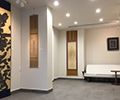SEARCH
About Zen and Zen Art
Zen (Ch: Chan) Buddhism was introduced to China by the Indian priest Bodhidharma in the early sixth century. It made its way to Japan in the early thirteenth century and was absorbed into Japanese religion and culture. A unique tradition within the East Asian cultural sphere, Zen went on to develop in distinctive ways in Japan. “What is Zen?” is a difficult question. Zen masters teach that Zen is achievement of a “formless self,” that is, a physically and mentally “formless” self, an entity where there is no good or bad, no beauty or ugliness, no truth or falseness, no birth or death. Zen is skeptical of a self that has form in reality. Not a mere belief or intuition, Zen questions everything, including Sakyamuni Buddha, the founder of Buddhism, and his great follower, Bodhidharma.
In Zen, attainment of a “formless self” is called enlightenment. “Buddha” means “enlightened one.” In the world of Zen, not only Sakyamuni, who lived 2500 years ago in India, but anyone who achieves enlightenment is buddha. It is because he attained enlightenment that Sakyamuni has been revered as Buddha. The buddha transcends specific time and space and is therefore the person with a “formless self” par excellence, who expresses him/herself freely in time and space.
What is Zen art? In Zen, the lively and dynamic workings of the “formless self” that is free of time and space in self-expression is known as zenki (lit., “workings of Zen”). Zen art represents these vibrant and dynamic workings reflected in calligraphy and painting. Zen is the essence of Buddhism, and Zen philosophy can open the way to end ethnic strife, terrorism, poverty, environmental destruction, and many other problems we face today. In no country does the spirit of Zen permeate such every part of daily life as in Japan. I would like to introduce, from Japan to the world, genuine Zen art works created by Zen masters whom Japanese have highly esteemed, thereby providing opportunities for more people to view Zen art, know the spirit of Zen, and learn the philosophy of Zen.
Recommended readings for further understanding of Zen:
- Critical Sermons of the Zen Tradition: Hisamatsu's Talks on Linji
by Shinichi Hisamatsu (Author), Gishin Tokiwa (Author), Christopher Ives (Author)
Publisher: University of Hawaii Press (December 31, 2002) - Zen & Fine Arts
by Shin'ichi Hisamatsu (Author)
Publisher: Kodansha America (December 1997) - The Formless Self
by Joan Stambaugh (Author)
Publisher:State University of New York Press (May 1999) - The Zen Monk's Life
by Daisetz Teitaro Suzuki (Author)
Publisher:Olympia Press (July 25, 2008) - The Unknown Craftsman: A Japanese Insight into Beauty
by Soetsu Yanagi (Author), Shoji Hamada (Foreword), Bernard Leach (Adapter)
Publisher:Kodansha International; Revised edition (January 15, 1990) - Acvaghosha's Discourse on the Awakening of Faith in the Mahayana
by Avaghosa Daisetz Teitaro Suzuki (Author)
Publisher:BiblioLife (Novemver 30,2008)

